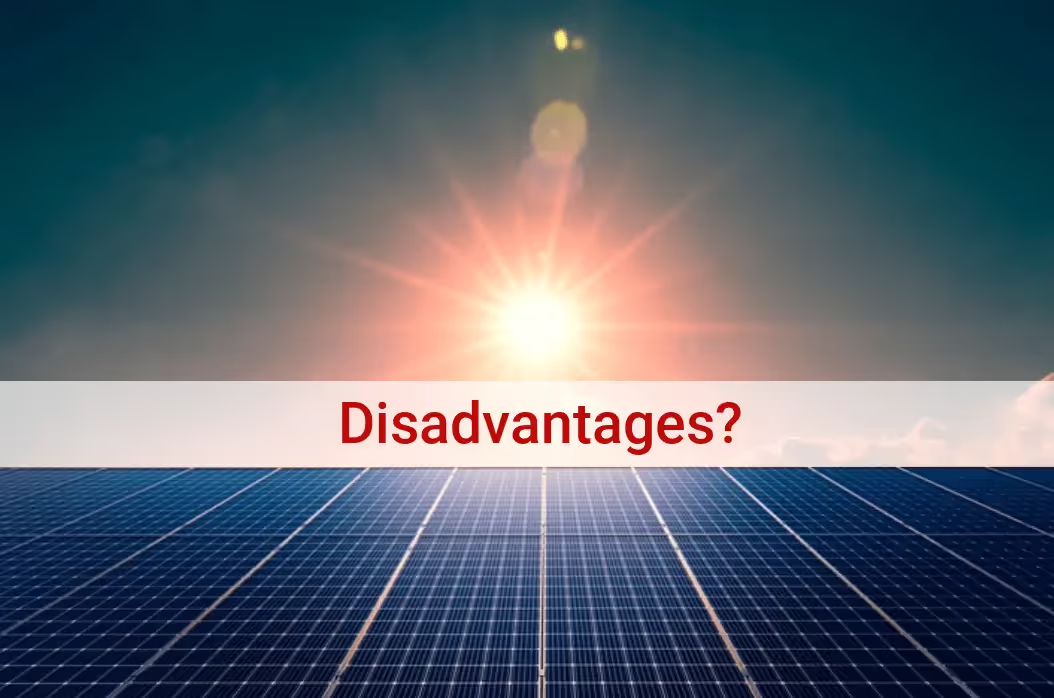
The 5 main disadvantages of installing solar panels are:
However, most of these disadvantages aren't disadvantages at all…
As an example, a basic solar panel system without a battery might cost £5,893 with Dwellow. A combination of utilising solar energy as it’s produced (assuming the right orientation and angle) and selling any excess back to the grid via the SEG, means you’ll may well have a payback period less than 13 years according to Energy Saving Trust.

Most roof spaces are suitable for solar panels, as long as they have reasonable structural integrity. However, the closer to a 30° tilt angle and facing due south…the better!
Efficiency loss can be an issue with low quality panels and represents a huge disadvantage. However, the likes of LONGi solar panels offer a 25-year performance guarantee, with a maximum of 0.4% degradation between year 2-25.
Of course, a big drawback of living in the UK is the weather; solar panels rely on sunlight. As you’ll see in more detail below, the further south you live, the more solar energy your panels will produce.
And finally, if you install panels on a DIY basis (or don’t use a MCS certified installer), you won’t be eligible for 0% VAT or for the SEG, this would mean:
Get solar panel quotes from MCS installers on high efficiency solar panels that qualify for both 0% VAT and the SEG scheme, by clicking here.
One of the main disadvantages of solar panels is their high upfront cost. Expect to pay around £6,000 for a 12-panel setup, and a further £2,495-£4,995 if you want a suitable storage battery.
But, with payback periods as low as 9-years, installing solar panels is still worth it, as we’ll explain in detail below.
Using our clickable solar panel tool here, we were able to input our electricity consumption and get an online roof scan.
This allows the tool to determine the best solar panel setup for any property. If you don’t know your electricity consumption, our tool can estimate it for you…
For the property in question, we inputted 4,100kWh/yr electricity consumption. And that would mean a 12-panel 5.16kW solar panel system would be the most suitable.
That’s going to cost just under £6,000 without a storage battery.
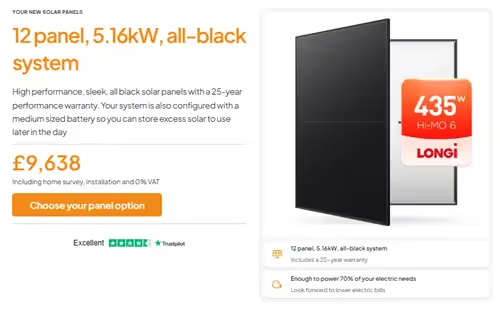
This isn’t a small investment. However, if you scroll down after getting your quote, you’ll see the estimated savings and payback period.
For this system, which doesn’t use a storage battery, you’d expect a payback period of approximately 9-years. Alongside this, you’d see savings of £625/yr on your electricity bill!
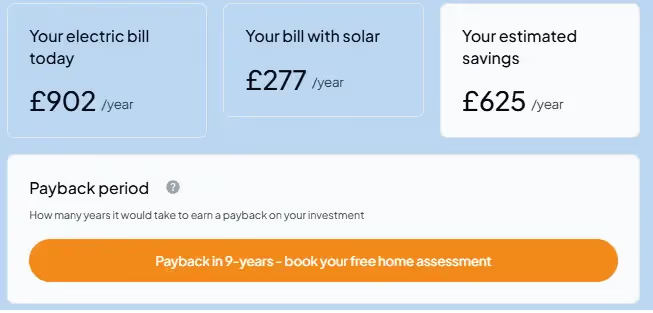
It’s worth mentioning that this is based on the average price per kWh of electricity today. Gas and electricity prices rarely go down. As they go up, your payback period will decrease, giving you a much better return on investment.
Whilst your payback period is approximately 9-years, the solar panels we fit generally come with a 25-year manufacturer’s warranty, and can last up to 40-years!
As an example, a popular choice is LONGi panels, which come with a 25-year performance guarantee.
So, whilst the upfront cost is a disadvantage at first glance, it can be offset by getting finance and covering those repayments via energy savings and Smart Export Guarantee income.
Get savings and payback period estimates specifically for your property by using our solar panel tool here.
If you’re already seeing upfront cost as the major drawback, you won’t want to install a solar storage battery. Solar batteries are expensive and can almost double the price of your installation cost.
The reasons for installing a battery alongside solar panels include:
Using the same property example as above, using a medium storage battery (£3,745), you’d save £757/yr rather than £625/yr. That’s going to increase your payback period to around 13-years from the initial 9.
You can see why many people see this as a disadvantage. A £3,745 outlay, to only save an extra £132/yr.
However, this doesn’t account for the rising cost of electricity, and protecting yourself from that cost.
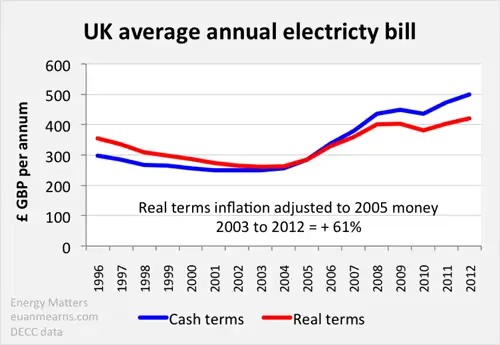
As you can see from this graph on Energy Matters, from the early 2000s up to 2012, energy prices nearly doubled. This highlights the real advantage of buying a storage battery; self-sufficiency.
The higher your level of self-sufficiency, the better protected you’re against rising energy costs.
Is self-sufficiency important to you? If so, then adding a solar battery is a massive plus, and you can configure your solar panels and battery by using our clickable solar panel tool here.
A major drawback to consider is that for solar panels to be suitable for your property you'll need your roof to be:
Put simply, you'll want a roof that has as close as possible to a 30° tilt angle and facing due south as possible. Don't worry if the spec's of your roof aren't exactly the same as this (these are simply the best).
You can see the "potential" efficiency of your solar panels based on roof pitch and orientation by referring to this graphic from the Energy Saving Trust.
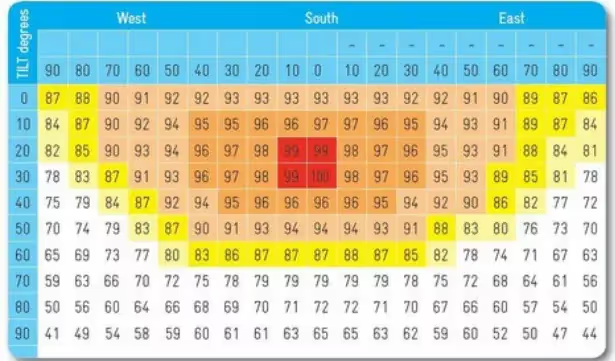
If you don’t have a suitable tilt angle or your roof isn’t orientated the right way, this is going to be a huge disadvantage. As you can see on the graphic above, there could be up to a 50% loss in electricity production compared to a 30° tilt angle and due south facing roof in some cases.
Alongside this, you’ll need your roof to have reasonable structural integrity. Solar panel systems can weigh over 300 kg, so your roof is going to need to hold that weight.
And finally, if your roof has lots of shading during daylight hours, this is a disadvantage to consider. Whether that shading comes from trees,neighbouring properties or even a chimney breast, shading is going to drastically reduce the electricity production of your solar panels.
We’ve written a more detailed guide to roof suitability for solar panels here. Or, go ahead and use our clickable tool to determine if your roof is ideal for solar panels.
One massively overlooked disadvantage of solar panels is their degradation rate. In short, solar panel’s efficiency reduces over time and that’s going to affect how much electricity they can produce.
For a visual representation of what this can look like over time, we’ll take a look at this graphic from 8 Billion Trees:
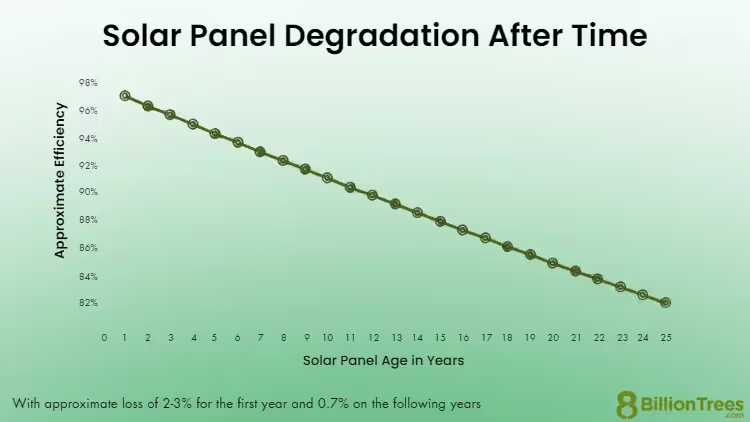
So whilst solar panels might be around 98% efficient on day 1, that quickly degrades to just above 84% by year 2025.
Does this as a disadvantage mean solar panels aren’t worth it? Not exactly.
What you need to do is find a solar panel manufacturer that offers:
If you read our LONGi solar panel review, that’s a perfect example. Degradation rates are much lower than the graphic above:

Further specs for the LONGi X6 can be found here.
Or, jump right ahead and get a solar panel quote for units offering a low degradation rate, yet high levels of efficiency using our clickable tool here.
One of the disadvantages of living in the UK? Our weather is….sub-par at best.
Alongside the efficiency of the panels you use and your roof suitability, where you live in the UK is going to have a huge bearing on how much electricity your solar panels produce.
Check out this graphic from Research Gate:
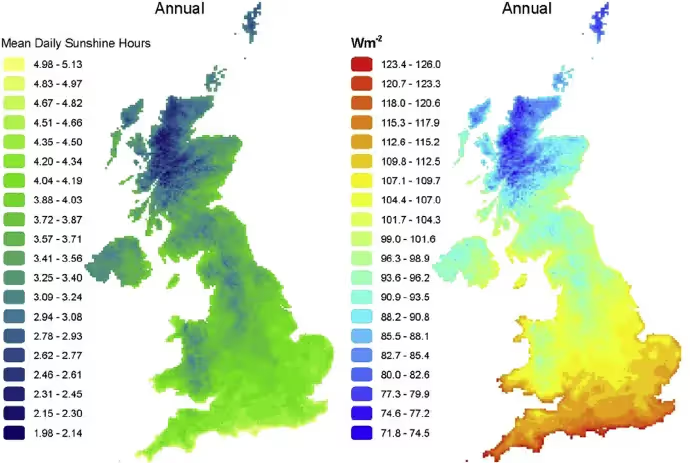
As you can see, living in The Highlands of Scotland could mean your daily sunlight hours are around 2 per day. That’s doubled to around 4 hours per day or higher when compared to the most southern parts of England.
Put simply, the further north you live, the less electricity you’re going to be producing via solar energy.
Using our clickable tool here (which includes a roof scan), you can get installation quotes, as well as determine how much money per year you’ll save on electricity bills.
If you plan to fit DIY solar panels, you’ll be at a major disadvantage. You won’t qualify for the government’s 0% VAT rate on green energy products, and you won’t be eligible for the Smart Export Guarantee.
Remember the solar panel quote we got above? That’s £5,893, but subject to 0% VAT. If you don’t use a VAT registered installer, you’d be paying £5,893+VAT (£7,071.60).

But that’s not the worst of it.
If you don’t use a MCS registered installer, you won’t be eligible for the Smart Export Guarantee (SEG). This is a scheme where you can sell any excess electricity you produce, and earn an income in the process.
In our solar panel quote above? £410/yr of your annual savings will be coming from the SEG.

To qualify for both of the above, you’ll need to use a MCS certified solar panel installer. All our installers are MCS certified, so you’ll be able to make the most out of the 0% VAT scheme and the Smart Export Guarantee.
Get solar panel prices from MCS certified installers by using our clickable tool here.
Try our free quote tool. You'll have your personalised quote in under a minute.